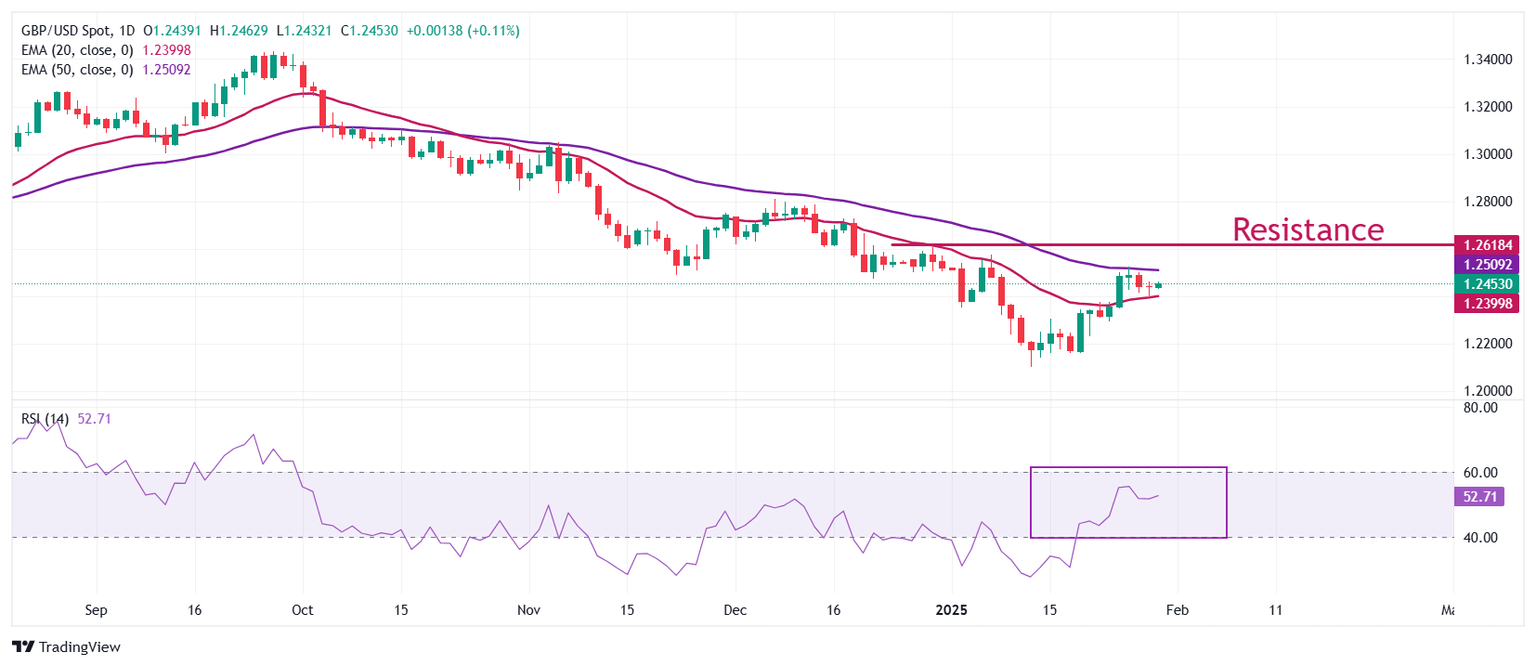Pound Sterling rises against USD on slower US GDP growth
- The Pound Sterling gains against the US Dollar after weak US Q4 GDP data.
- US President Trump vows to lower inflation himself through liberalization and ramping up Oil production.
- The BoE is expected to cut interest rates by 25 bps next week.

The Pound Sterling (GBP) rises to near 1.2460 against the US Dollar (USD) in North American trading hours on Thursday. The GBP/USD gains as the US Dollar drops after the advanced Gross Domestic Product (GDP) report for the fourth quarter of 2024 showed a slower-than-expected growth rate. The US economy expanded 2.3% year-over-year (YoY), slower than estimates of 2.6% and 3.1% growth seen in the third quarter of 2024.
Meanwhile, Initial Jobless Claims for the week ending January 24 were lower than projected. There were 207K individuals claiming jobless benefits for the first time, fewer than the estimates of 220K and the former release of 223 K. Lower jobless claims signal a steady labor demand, which could allow the Federal Reserve (Fed) to keep interest rates at their current levels for longer.
On Wednesday, the Fed left interest rates unchanged in the range of 4.25%-4.50% as expected, and guided a cautious stance. Fed Chair Jerome Powell said in the press conference that further monetary policy adjustments would become appropriate only if the central bank sees "real progress on inflation or at least some weakness in the labor market”.
Fed’s decision to pause the current policy-easing cycle is opposite to President Donald Trump’s views who called for immediate rate cuts in his speech at the World Economic Forum (WEF) in Davos. Powell commented, “The committee is very much in the mode of waiting to see what policies are enacted.”
After Powell’s speech, Trump said in a post on his social media company, Truth Social, that the Fed has done a “terrible job on Bank Regulation”. Trump added that he would “lower inflation himself through various initiatives including energy production, American manufacturing and slashing regulation.”
Investors will focus on the Personal Consumption Expenditure Price Index (PCE) data for December, which are scheduled to be released on Friday. The PCE price index data will show the current status of inflation. The core PCE inflation, the Federal Reserve’s (Fed) preferred inflation gauge, is estimated to have grown in December by 0.2%, faster than 0.1% in November on a month-on-month basis. Yearly figures rose steadily by 2.8%.
Daily digest market movers: Pound Sterling rises as UK Reeves aims to trim regulations
- The Pound Sterling trades strongly against its major peers, except for the Japanese Yen (JPY), in Thursday’s North American session. The British currency strengthens as United Kingdom (UK) Chancellor of the Exchequer Rachel Reeves provides a roadmap to ramp up economic growth. Reeves unveiled various measures to boost growth prospects, including a "growth corridor" between the university cities of Oxford and Cambridge, in her speech at Oxfordshire.
- Rachel Reeves reiterated Prime Minister Keir Starmer's positive outlook on the economy, saying that the economy is on the brisk of a “turnaround” in a speech in Oxfordshire. She vowed to remove "stifling and unpredictable" regulations to boost productivity. Reeves also mentioned that she is looking to “deepen their relationship” with the United States (US) under the leadership of President Donald Trump and looks forward to working with the new Treasury Secretary Scott Bessent.
- However, the impact of Reeves’ economic agenda is unlikely to fix, at least immediately, the issues the nation is facing, which are forcing the Bank of England (BoE) to resume the rate-cut cycle from the policy meeting next week.
- BoE officials are scheduled to meet in February and are expected to cut interest rates by 25 basis points (bps) to 4.5%. This would be the third interest rate cut by the BoE since August when borrowing rates rose to 5.25%.
British Pound PRICE Today
The table below shows the percentage change of British Pound (GBP) against listed major currencies today. British Pound was the strongest against the US Dollar.
| USD | EUR | GBP | JPY | CAD | AUD | NZD | CHF | |
|---|---|---|---|---|---|---|---|---|
| USD | -0.19% | -0.17% | -0.86% | -0.14% | -0.06% | -0.04% | -0.09% | |
| EUR | 0.19% | 0.01% | -0.66% | 0.05% | 0.12% | 0.16% | 0.09% | |
| GBP | 0.17% | -0.01% | -0.69% | 0.04% | 0.11% | 0.14% | 0.08% | |
| JPY | 0.86% | 0.66% | 0.69% | 0.71% | 0.79% | 0.79% | 0.75% | |
| CAD | 0.14% | -0.05% | -0.04% | -0.71% | 0.08% | 0.11% | 0.04% | |
| AUD | 0.06% | -0.12% | -0.11% | -0.79% | -0.08% | 0.03% | -0.01% | |
| NZD | 0.04% | -0.16% | -0.14% | -0.79% | -0.11% | -0.03% | -0.07% | |
| CHF | 0.09% | -0.09% | -0.08% | -0.75% | -0.04% | 0.00% | 0.07% |
The heat map shows percentage changes of major currencies against each other. The base currency is picked from the left column, while the quote currency is picked from the top row. For example, if you pick the British Pound from the left column and move along the horizontal line to the US Dollar, the percentage change displayed in the box will represent GBP (base)/USD (quote).
Technical Analysis: Pound Sterling continues to face pressure near 50-day EMA
The Pound Sterling exhibits a sharp volatility contraction around 1.2450 against the US Dollar on Thursday. The near-term outlook for the GBP/USD pair remains firm as it holds the 20-day Exponential Moving Average (EMA), which trades around 1.2400. However, the 50-day EMA near 1.2510 continues to be a major barrier for Sterling bulls.
The 14-day Relative Strength Index (RSI) moves higher above 50.00 from the 20.00-40.00 range, suggesting that the bearish momentum has ended, at least for now.
Looking down, the January 13 low of 1.2100 and the October 2023 low of 1.2040 will act as key support zones for the pair. On the upside, the December 30 high of 1.2607 will act as key resistance.
Economic Indicator
Gross Domestic Product Annualized
The real Gross Domestic Product (GDP) Annualized, released quarterly by the US Bureau of Economic Analysis, measures the value of the final goods and services produced in the United States in a given period of time. Changes in GDP are the most popular indicator of the nation’s overall economic health. The data is expressed at an annualized rate, which means that the rate has been adjusted to reflect the amount GDP would have changed over a year’s time, had it continued to grow at that specific rate. Generally speaking, a high reading is seen as bullish for the US Dollar (USD), while a low reading is seen as bearish.
Read more.Last release: Thu Jan 30, 2025 13:30 (Prel)
Frequency: Quarterly
Actual: 2.3%
Consensus: 2.6%
Previous: 3.1%
Source: US Bureau of Economic Analysis
The US Bureau of Economic Analysis (BEA) releases the Gross Domestic Product (GDP) growth on an annualized basis for each quarter. After publishing the first estimate, the BEA revises the data two more times, with the third release representing the final reading. Usually, the first estimate is the main market mover and a positive surprise is seen as a USD-positive development while a disappointing print is likely to weigh on the greenback. Market participants usually dismiss the second and third releases as they are generally not significant enough to meaningfully alter the growth picture.
Author

Sagar Dua
FXStreet
Sagar Dua is associated with the financial markets from his college days. Along with pursuing post-graduation in Commerce in 2014, he started his markets training with chart analysis.


















